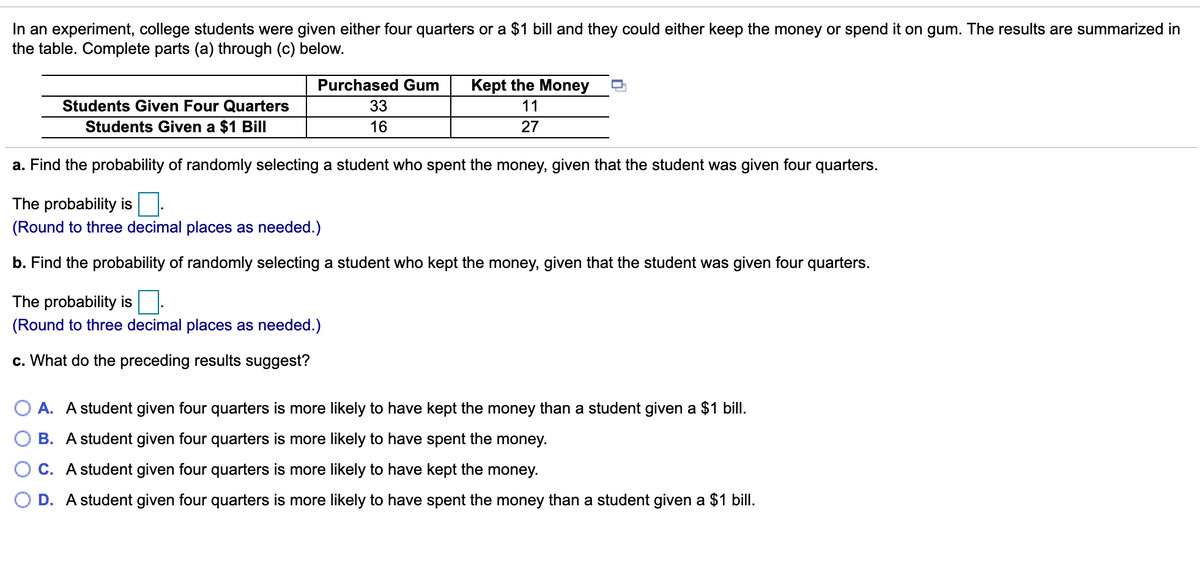a. Find the probability of randomly selecting a student who spent the money, given that the student was given four quarters. The probability is. (Round to three decimal places as needed.) b. Find the probability of randomly selecting a student who kept the money, given that the student was given four quarters. The probability is (Round to three decimal places as needed.) c. What do the preceding results suggest? O A. A student given four quarters is more likely to have kept the money than a student given a $1 bill. B. A student given four quarters is more likely to have spent the money. O C. A student given four quarters is more likely to have kept the money. O D. A student given four quarters is more likely to have spent the money than a student given a $1 bill.
a. Find the probability of randomly selecting a student who spent the money, given that the student was given four quarters. The probability is. (Round to three decimal places as needed.) b. Find the probability of randomly selecting a student who kept the money, given that the student was given four quarters. The probability is (Round to three decimal places as needed.) c. What do the preceding results suggest? O A. A student given four quarters is more likely to have kept the money than a student given a $1 bill. B. A student given four quarters is more likely to have spent the money. O C. A student given four quarters is more likely to have kept the money. O D. A student given four quarters is more likely to have spent the money than a student given a $1 bill.
Chapter8: Sequences, Series,and Probability
Section8.7: Probability
Problem 50E: Flexible Work Hours In a recent survey, people were asked whether they would prefer to work flexible...
Related questions
Question

Transcribed Image Text:In an experiment, college students were given either four quarters or a $1 bill and they could either keep the money or spend it on gum. The results are summarized in
the table. Complete parts (a) through (c) below.
Purchased Gum
Kept the Money
Students Given Four Quarters
33
11
Students Given a $1 Bill
16
27
a. Find the probability of randomly selecting a student who spent the money, given that the student was given four quarters.
The probability is:
(Round to three decimal places as needed.)
b. Find the probability of randomly selecting a student who kept the money, given that the student was given four quarters.
The probability is
(Round to three decimal places as needed.)
c. What do the preceding results suggest?
O A. A student given four quarters is more likely to have kept the money than a student given a $1 bill.
B. A student given four quarters is more likely to have spent the money.
C. A student given four quarters is more likely to have kept the money.
D. A student given four quarters is more likely to have spent the money than a student given a $1 bill.
Expert Solution
This question has been solved!
Explore an expertly crafted, step-by-step solution for a thorough understanding of key concepts.
This is a popular solution!
Trending now
This is a popular solution!
Step by step
Solved in 2 steps

Knowledge Booster
Learn more about
Need a deep-dive on the concept behind this application? Look no further. Learn more about this topic, statistics and related others by exploring similar questions and additional content below.Recommended textbooks for you


Glencoe Algebra 1, Student Edition, 9780079039897…
Algebra
ISBN:
9780079039897
Author:
Carter
Publisher:
McGraw Hill

College Algebra (MindTap Course List)
Algebra
ISBN:
9781305652231
Author:
R. David Gustafson, Jeff Hughes
Publisher:
Cengage Learning


Glencoe Algebra 1, Student Edition, 9780079039897…
Algebra
ISBN:
9780079039897
Author:
Carter
Publisher:
McGraw Hill

College Algebra (MindTap Course List)
Algebra
ISBN:
9781305652231
Author:
R. David Gustafson, Jeff Hughes
Publisher:
Cengage Learning